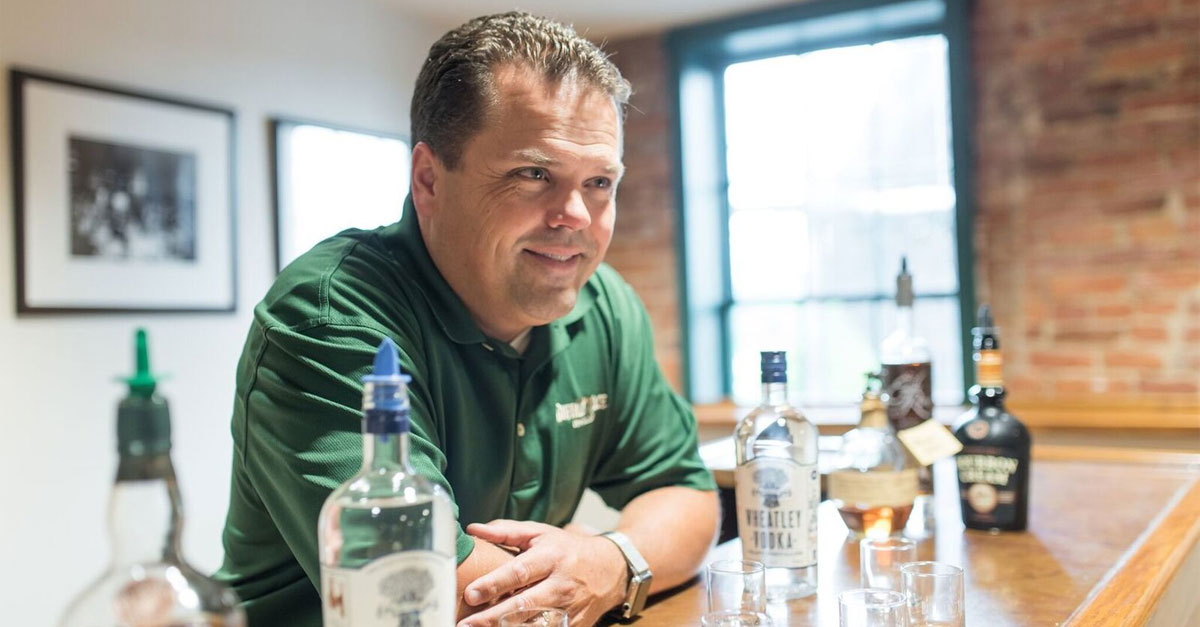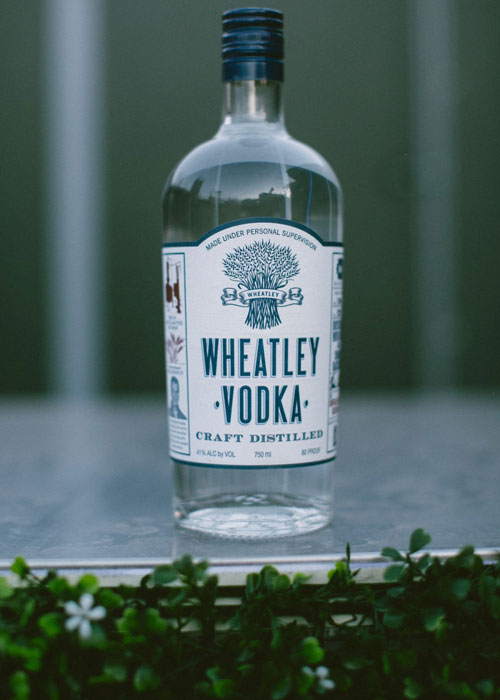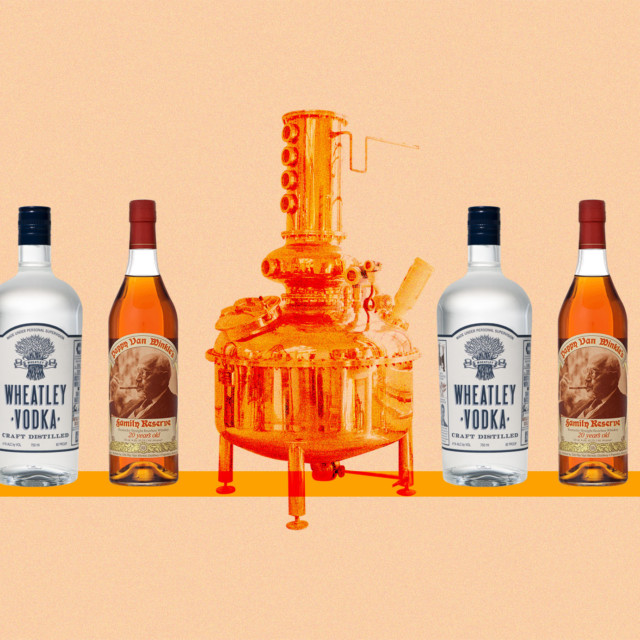In 1995, a 24-year-old Harlen Wheatley, fresh off a chemical engineering degree from the University of Kentucky, was hired as a supervisor at The Leestown Company’s George T. Stagg Distillery in Frankfort, Ky. This was still four years before Sazerac Company would turn it into the Buffalo Trace Distillery (and they’d release their flagship bourbon of the same name), seven years before they’d start producing Pappy Van Winkle, and two decades or so before Harlen Wheatley would become perhaps the most ballyhooed master distiller in the entire bourbon world. This was the mid-1990s and bourbon sales were still falling, and had been since 1970.
“We had a lot of equipment but it was all underutilized,” explains Wheatley of the legendary distillery that had surely seen better days. “We just didn’t have enough business.”
In fact, they had one giant column still that had never even been used before. It had been built in the late 1960s in order to eventually facilitate the production of light whiskey, a then-newly created category of mildly flavored product that more resembled vodka. However, that project went belly up and nearly three decades later the still was basically brand new.
“One of the marketing people came to the distilling team and asked, ‘Can you run that still again and make a vodka?’” recalls Wheatley.
“We could, but we really had no idea how to make vodka.”
Buy Wheatley, Land Pappy?
Whiskey drinkers do not care about vodka, they do not think about vodka, they certainly do not drink vodkas. And yet, if you ask the kinds of nuts who stalk liquor stores for allocated releases, who troll the secondary market looking to wheel and deal, and who spend all day online talking about bourbon, what they think of Wheatley Vodka, you’ll get a lot of similar responses.
“If you buy 1000 cases you too can get a Pappy 23!” writes a man on Reddit.
“It’s long been speculated that Sazerac has Republic [National Distributing Company] force things like Wheatley Vodka … on retailers in order for them to receive the desirable Buffalo Trace products,” claims another person.
“I’ve had multiple liquor store owners tell me that they are told in no uncertain terms that say they can get more [of the coveted Buffalo Trace] Antique Series if they are selling sh*tloads of Wheatley Vodka (sic),” states another.
So, why was a distillery in the heart of bourbon country, which produces the absolute most acclaimed bourbons in all of America, wasting their time also making vodka?
Like the bourbon internet believes, it had to be a cynical ploy, right?

Forget Pappy, Buffalo Trace Has a $300 Vodka
That first-ever vodka that Wheatley, working under then-master distiller Gary Gayheart, would help produce was called Rain, distilled from 100 percent organic white corn. By 1996, the George T. Stagg Distillery had also made Platinum 7X, distilled that many times. By 2005, Wheatley had taken over as master distiller after Gayheart’s retirement and in 2007 the E.H. Taylor, Jr. Micro Still, a custom-designed combo pot and column still named after the so-called “father” of the modern bourbon industry, was up and running.
“What that allowed us to do was experiment with different flavors,” says Wheatley. Although it would mostly be used for whiskey experimentation, Wheatley wanted to see what the limits of the still were. “I said, ‘I don’t care how long it takes, let’s make a really good vodka.’”
It would take four months, in fact, of constantly distilling, re-distilling, and batching, plus another 12 months of resting the liquid in stainless-steel tanks. Eventually, 28,400 gallons of mash was turned into 332 gallons of vodka. The total distillations clocked in at a whopping 159. (Remember, something like, say, Tito’s Vodka is only distilled six times.)
“It was a really, unbelievably smooth, mellow vodka,” says Wheatley. “Like so smooth you had to be careful.”
For the amount of time and effort that went into it, not to mention the custom-made crystal decanter and burl wood case it came in, Harlen D. Wheatley CLIX (159 in Roman numerals) would be priced at $300. A remarkable amount for vodka, especially in 2011 when a mere 2,000 bottles of it first hit shelves; all the more remarkable considering Sazerac has always set Pappy Van Winkle 23 Year’s MSRP at a reasonable $249.99.
“Still, we probably lost money on the deal,” jokes Wheatley, who even got a patent for his vodka-making process during the ordeal.
Though CLIX continues to be produced once a year, now it only takes around two months of work. It remains the rarest, priciest Buffalo Trace product most people have never heard of.
Putting the Wheat in Wheatley
In the two decades Wheatley had reported to work at the distillery in Frankfort, he’d watched the spirits world radically change. Domestic bourbon sales had dropped more than 50 percent since the year he was born (1969) and even by 1995 they were sputtering. Meanwhile, vodka sales in the U.S. had been booming since the 1970s, when it became the country’s most consumed spirit.
By the 2010s, though, bourbon again was on the rise. Wheatley’s profile as a master distiller, and the profile of his most famous whiskeys, were soon to reach astronomical levels. Most all Buffalo Trace whiskeys were likewise soon to become impossible to find, necessitating — or perhaps greedily causing — the company to begin releasing line extensions like Stagg Jr., Weller Full Proof, and the amusingly named Double Eagle Very Rare, which likewise were eagerly snapped up.
Which makes it even more strange that, as bourbon and vodka’s fortunes were seemingly flip-flopping, Wheatley decided he wanted to briefly shift his focus to the latter. In fact, he wanted to produce a “craft”-style vodka that could also proudly represent the Buffalo Trace Distillery. Of course, terms like “craft” (and “artisanal” and “handmade”) are often nonsense in the vodka world.
“Virtually all of the vodka made in the U.S., including Tito’s and Smirnoff, starts as grain neutral spirit (GNS) manufactured by one of the major producers: Archer Daniels Midland (ADM), Midwest Grain Products (MGP), or Grain Processing Corporation (GPC), whose headquarters and principal distilleries are in Illinois, Kansas, and Iowa, respectively (i.e., where most grain is farmed),” explains whiskey historian Chuck Cowdery. The vodka brands will take this GNS and then either redistill it, like Tito’s does, or sometimes just directly bottle it.
That wouldn’t be the case with Wheatley’s, whose mash bill predominantly consists of corn and the exact same soft red winter wheat used in the Van Winkle and Weller line. It might very well be the same mash bill, in fact. Which makes one wonder if the taters who began clearing the shelves of Weller 12 and Old Weller Antique because they’d heard it was “Poor Man’s Pappy” will begin clearing the shelves of Wheatley Vodka now that they know it’s made with Pappy’s wheat. (I can already picture some knucklehead using a tiny oak barrel to home-age Wheatley Vodka into “Pappy.”)
Once fermented, indeed, it could literally be used to make bourbon. Of course, vodka is distilled to a much higher 190 proof to strip away most aroma and flavor. But not all of it. Wheatley Vodka is delicate, with notes of vanilla and little of that typical ethanol burn.
“I think it’s an unusual thing to do,” says Wheatley in regards to his process and his lack of reliance on sourcing GNS. “When you walk down the vodka aisle, 80 percent or more are straight neutral spirit — it’s all about packaging and the story.”

A Legendary Craftsman
Buffalo Trace is a company built of much-coveted bourbons and ryes all with the names of legendary men from American whiskey’s past.
There’s Blanton’s, named after the Kentucky colonel who was once the distillery’s president; Elmer T. Lee, named after the distillery’s legendary master distiller of the 1980s; George T. Stagg, after the man who built the most successful American distillery during bourbon’s so-called gilded age; and, of course, Pappy Van Winkle, to honor the founder of the vaunted Stitzel-Weller Distillery, which pretty much invented wheated bourbon.
Unlike all those men — and, actually, every single man listed on the “legendary craftsmen” page of Buffalo Trace’s website — Harlen Wheatley is still very much alive and still very much a craftsman. And, yet, unlike all those other men, his name (and face) is not on a whiskey, but instead on this vodka.
Was it possible Harlen Wheatley preferred vodka more than the legendary bourbons he distilled? (That would certainly make for some great clickbait: “SHOCKER! Pappy’s Master Distiller Only Drinks Vodka”.)
But, no, not really. Wheatley confesses he rarely drinks vodka, in fact, preferring a Buffalo Trace Manhattan or a homemade amaretto and bourbon cocktail he created, when he’s sipping off the clock, of course.
So surely the online intelligentsia had to be right. Wheatley Vodka was created simply to force businesses to buy a lot of it in exchange for access to all those allocated Buffalo Trace whiskeys.
“It does not work that way,” Mike Vacheresse, owner of Brooklyn’s Travel Bar, one of New York’s top whiskey destinations, tells me. “That is 1,000 percent not true.”
Most all on- and off-premise proprietors I spoke to essentially told me the same thing. One retail store owner in California, who wished to remain anonymous, flat-out told me that people in the industry would laugh at me if I really were to claim that buying a ton of Wheatley Vodka was the one thing that guaranteed you would get Buffalo Trace’s allocated whiskeys.
“If that was the case, why wouldn’t every store have Wheatley stacked to the ceiling?” he asks.
The fact is, Wheatley’s name came to be on the bottle because Sazerac’s then-vice president of sales and marketing, Steve Wyant, recommended it. He knew that Harlen Wheatley may not be famous to the world at large, but he is very famous among the bourbon cognoscenti. Wyant thought they might see his name on the vodka and, now assured of its quality, might recommend it to vodka-drinking friends and family.
So, yes, Wheatley Vodka is indeed a ploy, but not a cynical ploy.
“My only stipulation was, we’re not going to make bubblegum vodka and put my name on it,” says Wheatley. He recognizes that, according to company data, 35 percent of drinkers exclusively drink vodka and it would be a good thing to get that business; a good thing to become the one bottle of vodka sold at top whiskey bars. “And, if you’re going to put my name on it, it better well be damn good.”
According to many people it is — and not just vodka drinkers, either. It has won countless awards and garnered much praise from bartenders and others in the booze industry. No less than Julian Van Winkle, Pappy’s grandson and the president of Old Rip Van Winkle Distillery, admits he’s a fan of Wheatley Vodka. So is Vacheresse, who only stocks three vodkas at his whiskey bar, using a housemade, dill-infused Wheatley Vodka in his Nordic cocktail.
A lot of regular folk are fans, too. It started as a gift-shop-only release on the Buffalo Trace campus but was such a hit that after three months distributors started imploring the distillery to let them push it wide. Today, it’s sold in all 50 states and a few countries abroad, and maintains double-digit growth year-to-year.
(Don’t worry, making more vodka doesn’t mean Buffalo Trace will have to make less whiskey to accommodate that production. Five years ago, Buffalo Trace installed a dedicated vodka still.)
It’s cheap too, usually around $17 a bottle, which puts it well below the costs of the Belvederes and Grey Gooses of the world. That’s perhaps the reason why it replaced Tito’s on United Airlines flights starting in 2018. Now, while many smaller distilleries need to pump out vodka in order to make money, Wheatley claims his reason for making vodka is simply so vodka drinkers have something good to drink.
“There’s really no agenda whatsoever,” says Wheatley. “People ask why is a bourbon distillery making vodka?
“Because we can.”
